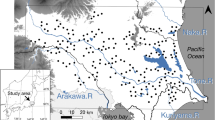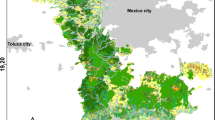Abstract
Rice paddies function as wetlands; therefore, abandoned paddy fields cause a loss of habitats for aquatic species, such as amphibians. Following the accident at the Fukushima Daiichi Nuclear Power Plant in 2011, paddy fields around the plant were abandoned and rapidly dried. To identify the impact of large-scale abandonment of paddy fields on the habitats of frogs, we investigated changes in the distributions of four frogs that breed in paddy fields using niche modeling and field surveys. The spatial distributions of suitable habitats before and after the accident for each frog were created using MaxEnt. In the area where rice cropping was restricted due to radioactive contamination, the areas of suitable habitats decreased for Pelophylax porosus porosus but increased or remained unchanged for other frogs after the accident. Additionally, field surveys conducted in 2014 indicated that the ratios of breeding sites in the area where rice cropping was restricted were significantly lower for P. p. porosus and Hyla japonica than outside this area. Thus, 3 years after the accident, one species strongly dependent upon paddy fields rapidly disappeared over a large area. Although amphibian populations or monitoring data were not available to examine changes directly after the accident in the study area, this research showed that the combination of niche modeling and field survey was effective for predicting species response after an accident and revealed that large-scale disasters sufficient to disrupt agricultural activity could markedly change the distribution of species reliant on habitats created by human activity.






Similar content being viewed by others
References
Azuma A, Takeuchi K (1999) Relationships between population density of frogs and environmental conditions in Yatsu-habitat. J Jpn Inst Landsc Architect 62:573–576. https://doi.org/10.5632/jila.62.573(inJapanesewithEnglishabstract)
Beresford NA, Scott EM, Copplestone D (2020) Field effects studies in the Chernobyl exclusion zone: lessons to be learnt. J Environ Radioact 211:105893. https://doi.org/10.1016/j.jenvrad.2019.01.005
Bonisoli-Alquati A, Koyama K, Tedeschi DJ et al (2015) Abundance and genetic damage of barn swallows from Fukushima. Sci Rep 5:9432. https://doi.org/10.1038/srep09432
City History Editing Office, Cultural Assets Department, Haramachi City Board of Education (2005) Haramachi City History, Volume 8 (special volume 1) Nature. Haramachi City, Fukushima. Japan (in Japanese)
Deryabina TG, Kuchmel SV, Nagorskaya LL et al (2015) Long-term census data reveal abundant wildlife populations at Chernobyl. Curr Biol 25:R824–R826. https://doi.org/10.1016/j.cub.2015.08.017
Elith J, Kearney M, Phillips S (2010) The art of modelling range shifting species. Methods Ecol Evol 1:330–342. https://doi.org/10.1111/j.2041-210X.2010.00036.x
Elith J, Phillips SJ, Hastie T et al (2011) A statistical explanation of MaxEnt for ecologists. Divers Distrib 17:43–57. https://doi.org/10.1111/j.1472-4642.2010.00725.x
Ficetola GF, Maiorano L, Falcucci A et al (2010) Knowing the past to predict the future: land-use change and the distribution of invasive bullfrogs. Glob Chang Biol 16:528–537. https://doi.org/10.1111/j.1365-2486.2009.01957.x
Fujimoto R, Mitsunaga T, Takeuchi M (2015) Influence of evacuation orders on the occurrence of the wild boar Sus scrofa in farmlands in the northern evacuation zone of the accident at Tokyo Electric Power Company’s Fukushima Daiichi Nuclear Power Station. Honyurui Kagaku (mammal Sci) 55:145–154. https://doi.org/10.11238/mammalianscience.55.145 (in Japanese with English abstract)
Fujioka M, Lane SJ (1997) The impact of changing irrigation practices in rice fields on frog populations of the Kanto Plain, central Japan. Ecol Res 12:101–108
Fukushima Prefecture (2017) Regarding the review of areas by Reconstruction of Evacuation area division. http://www.pref.fukushima.lg.jp/sec/11050a/hinanchiiki-kuiki.html. Accessed 17 Jan 2018. (in Japanese)
Fuma S, Une Y, Ihara S et al (2014) Effects of chronic γ-irradiation on growth and survival of the Tohoku hynobiid salamander, Hynobius lichenatus. J Environ Radioact 135:84–92. https://doi.org/10.1016/j.jenvrad.2014.04.001
Geospatial Information Authority of Japan (2001) Numerical value map 50m mesh. Geographical Survey Institute, Tsukuba
Geraskin SA, Fesenko SV, Alexakhin RM (2008) Effects of non-human species irradiation after the Chernobyl NPP accident. Environ Int 34:880–897. https://doi.org/10.1016/j.envint.2007.12.012
Guisan A, Tingley R, Baumgartner JB et al (2013) Predicting species distributions for conservation decisions. Ecol Lett 16:1424–1435. https://doi.org/10.1111/ele.12189
Hostert P, Kuemmerle T, Prishchepov A et al (2011) Rapid land use change after socio-economic disturbances: the collapse of the Soviet-Union versus Chernobyl. Env Res Lett 6:045201. https://doi.org/10.1088/1748-9326/6/4/045201
Ihara S (2014) Food Habits of the Adult Japanese Newt Cynops pyrrhogaster (Amphibia: Salamandridae) in the Sub-alpine Yachidaira High Moor, East-Central Honshu, Japan. Curr Herpetol 33:38–45. https://doi.org/10.5358/hsj.33.38
Ishihara M, Tadono T (2017) Land cover changes induced by the great east Japan earthquake in 2011. Sci Rep 7:45769. https://doi.org/10.1038/srep45769
Japan Aerospace Exploration Agency (JAXA) (2018) Homepage of high-resolution land use and land cover map products. https://www.eorc.jaxa.jp/ALOS/en/lulc/lulc_index.htm. Accessed 15 Jan 2019
Japan Meteorological Agency (2012) Mesh Climatic data 2010. http://nlftp.mlit.go.jp/ksj/index.html. Accessed 15 Jan 2019. (in Japanese)
Jueterbock A, Smolina I, Coyer JA, Hoarau G (2016) The fate of the Arctic seaweed Fucus distichus under climate change: an ecological niche modeling approach. Ecol Evol 6:1712–1724. https://doi.org/10.1002/ece3.2001
Katayama N, Baba Y, Kusumoto Y, Tanaka K (2015) A review of post-war changes in rice farming and biodiversity in Japan. Agr Syst 132:73–84. https://doi.org/10.1016/j.agsy.2014.09.001
Kidera N, Kadoya T, Yamano H et al (2018) Hydrological effects of paddy improvement and abandonment on amphibian populations; long-term trends of the Japanese brown frog, Rana japonica. Biol Cons 219:96–104. https://doi.org/10.1016/j.biocon.2018.01.007
Koshida C, Katayama N (2018) Meta analysis of the effects of rice field abandonment on biodiversity in Japan. Conserv Biol 32:1392–1402. https://doi.org/10.1111/cobi.13156
Liu C, White M, Newell G (2013) Selecting thresholds for the prediction of species occurrence with presence-only data. J Biogeogr 40:778–789. https://doi.org/10.1111/jbi.12058
Lyons PC, Okuda K, Hamilton MT, Hinton TG, Beasley JC (2020) Rewilding of Fukushima’s human evacuation zone. Front Ecol Environ 18(3):127–134. https://doi.org/10.1002/fee.2149
Marunouchi J, Kusano T, Ueda H (2002) Fluctuation in abundance and age structure of a breeding population of the Japanese brown frog, Rana japonica Günther (Amphibia, Anura). Zoolog Sci 19:343–350. https://doi.org/10.2108/zsj.19.343
Matsui M, Maeda N (2018) Encyclopaedia of Japanese frogs. Bun-ichi sogo syuppan, Tokyo
Matsushima N, Kawata M (2005) The choice of oviposition site and the effects of density and oviposition timing on survivorship in Rana japonica. Ecol Res 20:81–86. https://doi.org/10.1007/s11284-004-0010-0
Matsushima N, Ihara S, Takase M, Horiguchi T (2015) Assessment of radiocesium contamination in frogs 18 months after the Fukushima Daiichi nuclear disaster. Sci Rep 5:9712. https://doi.org/10.1038/srep09712
Ministry of Agriculture, Forestry and Fisheries of Japan (2014) About efforts related to cultivation of rice made in 2014 in the Areas under Evacuation Orders etc. (Target areas such as cropping restrictions of rice made in 2014). http://www.maff.go.jp/j/press/seisan/kokumotu/140307.html. Accessed 7 April 2018. (in Japanese)
Ministry of Agriculture, Forestry and Fisheries of Japan (2018) Farm products statistical surveys, data of municipalities, rice acreage. http://www.maff.go.jp/j/tokei/kouhyou/sakumotu/menseki/index.html. Accessed 17 April 2018. (in Japanese)
Ministry of Environment, Government of Japan (2006) The Red List of threatened species, Japan. http://www.biodic.go.jp/english/rdb/rdb_f.html
Mitamura T, Arakawa A, Kishi M et al (2013) Selection of functional biodiversity indicators and development of assessment methods in paddy fields of Fukushima Prefecture. Bull Fukushima Agric Technol Centre 5:43–61 (in Japanese with English abstract)
Møller AP, Mousseau TA (2006) Biological consequences of Chernobyl: 20 years on. Trends Ecol Evol 21:200–207. https://doi.org/10.1016/j.tree.2006.01.008
Møller AP, Mousseau TA (2011) Conservation consequences of Chernobyl and other nuclear accidents. Biol Conserv 144:2787–2798. https://doi.org/10.1016/j.biocon.2011.08.009
Møller AP, Mousseau TA (2013) Assessing effects of radiation on abundance of mammals and predator–prey interactions in Chernobyl using tracks in the snow. Ecol Indic 26:112–116. https://doi.org/10.1016/j.ecolind.2012.10.025
Møller AP, Nishiumi I, Suzuki H et al (2013) Differences in effects of radiation on abundance of animals in Fukushima and Chernobyl. Ecol Indic 24:75–81. https://doi.org/10.1016/j.ecolind.2012.06.001
Møller AP, Nishiumi I, Mousseau TA (2015) Cumulative effects of radioactivity from Fukushima on the abundance and biodiversity of birds. J Ornithol 156:297–305. https://doi.org/10.1007/s10336-015-1197-2
Murase K, Murase J, Horie R, Endo K (2015) Effects of the Fukushima Daiichi nuclear accident on goshawk reproduction. Sci Rep 5:9405. https://doi.org/10.1038/srep09405
Murphy JF, Nagorskaya LL, Smith JT (2011) Abundance and diversity of aquatic macroinvertebrate communities in lakes exposed to Chernobyl-derived ionising radiation. J Env Radioact 102:688–694. https://doi.org/10.1016/j.jenvrad.2011.04.007
Namie Town History Editing Committee (2003) Namie town history. Supplementary volume 1. Nature of Namie town. Namie town, Fukushima, Japan (in Japanese)
Natuhara Y (2013) Ecosystem services by paddy fields as substitutes of natural wetlands in Japan. Ecol Eng 56:97–106. https://doi.org/10.1016/j.ecoleng.2012.04.026
Phillips SJ, Anderson RP, Schapire RE (2006) Maximum entropy modeling of species geographic distributions. Ecol Model 190:231–259. https://doi.org/10.1016/j.ecolmodel.2005.03.026
QGIS Development Team (2016) QGIS2.18.2.7 GeographicInformationSystem. Open Source Geospatial Foundation Project. http://qgis.osgeo.org
R Core Team (2018) R: a language and environment for statistical computing. Version 3.3.4. R Foundation for Statistical Computing, Vienna. https://www.R-project.org/
Reconstruction Agency (2012) Current status and efforts of reconstruction (11 June 2012) http://www.reconstruction.go.jp/topics/120611torikumitogenjo.pdf. Accessed 17 Jan 2018. (in Japanese)
Sakai M, Gomi T, Nunokawa M, Wakahara T, Onda Y (2014) Soil removal as a decontamination practice and radiocesium accumulation in tadpoles in rice paddies at Fukushima. Environ Pollut 187:112–115. https://doi.org/10.1016/j.envpol.2014.01.002
Statistics Bureau, Ministry of Internal Affairs and Communications Japan (2018) Grid Square Statistics. http://www.stat.go.jp/english/data/mesh/index.htm. Accessed 31 Jan 2018.
Tagami K, Uchida S, Wood MD, Beresford NA (2018) Radiocaesium transfer and radiation exposure of frogs in Fukushima Prefecture. Sci Rep 8:10662. https://doi.org/10.1038/s41598-018-28866-0
Tamaoki M (2016) Studies on radiation effects from the Fukushima nuclear accident on wild organisms and ecosystems. Glob Environ Res 20:73–82
Togane D, Fukuyama K, Takai K, Kuramoto N (2018) Body size and age structure in two populations of Tokyo Daruma pond frog, Pelophylax porosus porosus. Curr Herpetol 37:58–68. https://doi.org/10.5358/hsj.37.58
von Wehrden H, Fischer J, Brandt P et al (2012) Consequences of nuclear accidents for biodiversity and ecosystem services. Conserv Lett 5:81–89. https://doi.org/10.1111/j.1755-263X.2011.00217.x
Warren DL, Siefert SN (2011) Ecological niche modeling in Maxent: the importance of model complexity and the performance of model selection criteria. Ecol Appl 21:335–342. https://doi.org/10.1890/10-1171.1
Washitani I (2001) Traditional sustainable ecosystem’SATOYAMA’and biodiversity crisis in Japan: conservation ecological perspective. Global Env Res 5:119–133
Webster SC, Byrne ME, Lance SL et al (2016) Where the wild things are: influence of radiation on the distribution of four mammalian species within the Chernobyl Exclusion Zone. Front Ecol Env 14:185–190. https://doi.org/10.1002/fee.1227
Yoshioka A, Mishima Y, Fukasawa K (2015) Pollinators and other flying insects inside and outside the Fukushima Evacuation Zone. PLoS ONE 10:e0140957. https://doi.org/10.1371/journal.pone.0140957
Yoshioka A, Matsushima N, Jingu S, Kumada N, Yokota R, Totsu K, Fukasawa K (2020) Acoustic monitoring data of anuran species inside and outside the evacuation zone of the Fukushima Daiichi power plant accident. Ecol Res 35:765–772. https://doi.org/10.1111/1440-1703.12121
Acknowledgements
We express our gratitude to the Fukushima prefectural government for their permission to enter the evacuation area. We are also grateful to Drs. T. Hayashi, K. Fukasawa, A. Yoshioka, Y. Mishima, and two anonymous reviewers for their valuable comments and suggestions. This study was financially supported by the Ministry of the Environment, Government of Japan, and in part by JSPS KAKENHI (Grant number JP16K16224).
Author information
Authors and Affiliations
Contributions
NM and TH conceived and designed the survey. NM, SI, OI and TH performed the survey. OI provided additional data. NM analyzed the data and wrote the manuscript; other authors provided editorial advice.
Corresponding author
Ethics declarations
Conflict of interest
The authors declare no conflict of interest.
Additional information
Communicated by Raoul Van Damme.
Supplementary Information
Below is the link to the electronic supplementary material.
Rights and permissions
About this article
Cite this article
Matsushima, N., Ihara, S., Inaba, O. et al. Assessing the impact of large-scale farmland abandonment on the habitat distributions of frog species after the Fukushima nuclear accident. Oecologia 196, 1219–1232 (2021). https://doi.org/10.1007/s00442-021-04991-y
Received:
Accepted:
Published:
Issue Date:
DOI: https://doi.org/10.1007/s00442-021-04991-y




